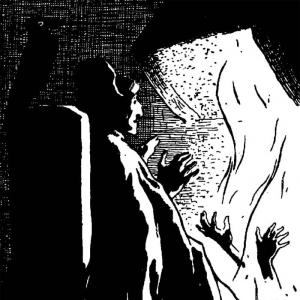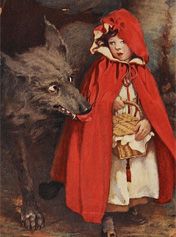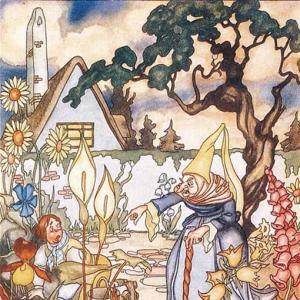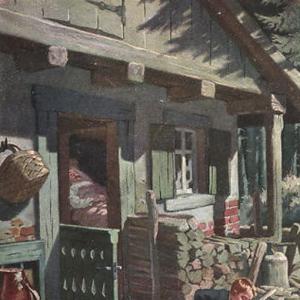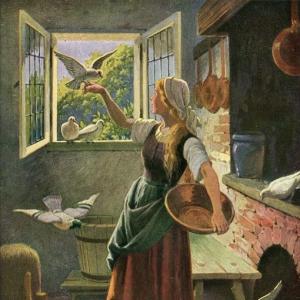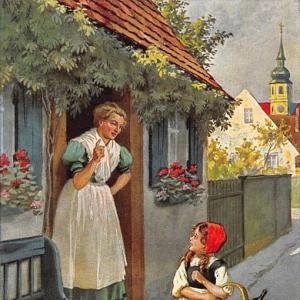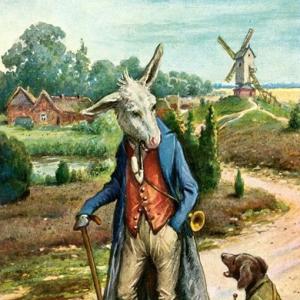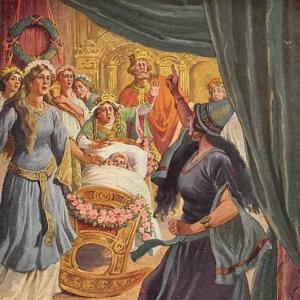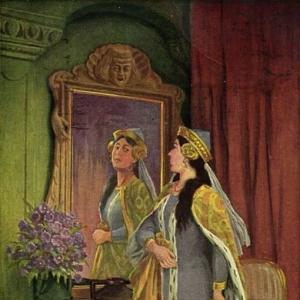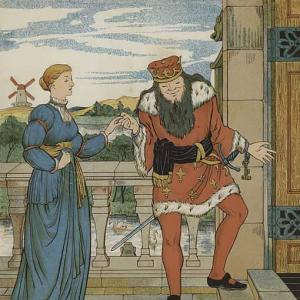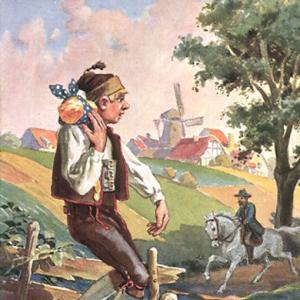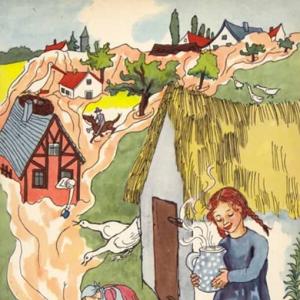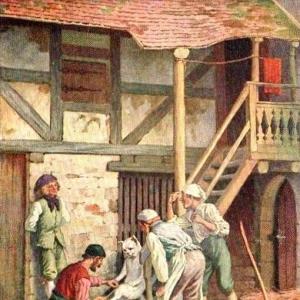Reading time for children: 3 min
There was once a young shepherd who wished much to marry, and was acquainted with three sisters who were all equally pretty, so that it was difficult to him to make a choice, and he could not decide to give the preference to any one of them. Then he asked his mother for advice, and she said, „Invite all three, and set some cheese before them, and watch how they eat it.“ The youth did so. The first, however, swallowed the cheese with the rind on. The second hastily cut the rind off the cheese, but she cut it so quickly that she left much good cheese with it, and threw that away also. The third peeled the rind off carefully, and cut neither too much nor too little. The shepherd told all this to his mother, who said, „Take the third for thy wife.“ This he did, and lived contentedly and happily with her.
 Learn languages. Double-tap on a word.Learn languages in context with Childstories.org and Deepl.com.
Learn languages. Double-tap on a word.Learn languages in context with Childstories.org and Deepl.com.Backgrounds
Interpretations
Adaptions
Summary
Linguistics
„Brides on their Trial“ is a lesser-known fairy tale from the collection of German folktales compiled by the Brothers Grimm, Jacob and Wilhelm. The Brothers Grimm were prominent linguists and cultural researchers in the 19th century, and they gathered tales from various sources, including oral traditions and written works. Their collection, known as „Grimm’s Fairy Tales“ or „Children’s and Household Tales,“ contains over 200 stories, including more famous tales like „Cinderella,“ „Snow White,“ and „Hansel and Gretel.“
The Brothers Grimm aimed to preserve the German folk tradition and culture by documenting these stories, which had been passed down through generations. Their work not only served as a cultural record but also had a profound influence on literature, folklore, and storytelling across the world.
„Brides on their Trial“ is a short and straightforward tale, illustrating important life lessons through the simple act of eating cheese. While not as widely recognized as other Grimm stories, it still offers valuable insights into human nature, decision-making, and the importance of inner qualities over outer beauty. The story, like many other Grimm fairy tales, contains elements of wisdom and guidance, which serve as moral lessons for readers.
„Brides on their Trial“ can be interpreted in various ways. Here are a few possible interpretations:
The importance of careful observation: The story highlights the importance of observing and understanding people’s behaviors before making a decision, especially in choosing a life partner. The mother’s advice helps the shepherd make an informed choice by examining the sisters‘ approach to a simple task.
Attention to detail: The way the sisters handle the cheese is symbolic of their personality and approach to life. The third sister’s careful and thoughtful approach to peeling the cheese shows that she is attentive to details and values resources, which are desirable qualities in a spouse and for managing a household.
Wisdom and guidance from elders: The shepherd seeks advice from his mother, who provides him with a simple but effective test to help him choose a suitable wife. This illustrates the value of listening to the wisdom and experience of our elders when making important decisions.
Inner qualities over outer beauty: While all three sisters are equally beautiful, the shepherd’s final decision is based on their actions and character rather than their physical appearance. This interpretation underscores the importance of valuing inner qualities over superficial beauty when selecting a life partner.
Prudence and balance: The third sister’s approach to removing the cheese rind demonstrates a balanced and measured approach to life. She is neither wasteful nor careless, and this quality makes her the ideal wife for the shepherd. The story serves as a reminder of the importance of prudence and balance in our daily lives.
The fairy tale „Brides on their Trial,“ also known as „The Twelve Brothers,“ has been adapted in various forms of media over the years. Here are a few notable adaptations:
Operas: The fairy tale has been adapted into several operas, including „Die zwölf Brüder“ by Austrian composer Johann Joseph Abert and „Les douze frères“ by French composer Ernest Chausson.
Ballets: The story has also been adapted into ballets, including „The Twelve Brothers“ by American choreographer George Balanchine.
Films: The fairy tale has been adapted into several films, including the 1949 Soviet film „The Twelve Months“ and the 2013 German film „The 12th Day.“
TV Shows: The story has been adapted into several TV shows, including an episode of the animated TV series „Simsala Grimm“ and an episode of the live-action TV series „Once Upon a Time.“
Children’s Books: The tale has been adapted into many children’s books, including „The Twelve Brothers“ by Jacob and Wilhelm Grimm and „The Twelve Dancing Princesses and Other Fairy Tales“ by Andrew Lang.
Each adaptation brings its unique interpretation of the story and characters, but the fundamental themes and motifs remain consistent throughout.
„Brides on their Trial“ is a fairy tale by the Brothers Grimm that tells the story of a young shepherd who is unsure of which of the three equally beautiful sisters he should marry. Seeking advice from his mother, she suggests he observe the sisters‘ actions while eating cheese. Following her advice, the shepherd invites the sisters over and serves them cheese. The first sister devours the cheese with the rind still on, while the second sister hastily removes the rind, but in her haste, she also wastes a significant portion of the cheese. The third sister, however, carefully peels off the rind, ensuring not to waste any of the cheese or take off too much. After reporting his observations to his mother, she recommends he marry the third sister. He does so and enjoys a happy, contented life with her.
The fairy tale „Brides on Their Trial“ by the Brothers Grimm presents a simple yet effective narrative that provides insight into human behavior and decision-making through symbolic linguistic elements.
Characterization through Actions: The three sisters are primarily characterized not through dialogue or detailed description, but through their actions, specifically how they eat cheese. This action serves as a metaphor for their personalities and values, with each sister’s approach to the cheese reflecting different attitudes towards life and resources. The first sister’s action of eating cheese with the rind suggests carelessness or a lack of attention to detail. The second sister’s hasty cutting, which wastes good cheese, indicates recklessness or wastefulness. The third sister’s careful peeling demonstrates thoughtfulness, precision, and moderation.
Symbolism of Cheese: Cheese in this tale serves as a symbol of the resources or tasks in life. The rind may represent challenges or obstacles that must be skillfully navigated to achieve the best results. The act of peeling cheese becomes a test or a trial, serving as a metaphor for making life choices and handling responsibilities.
Role of Maternal Advice: The shepherd relies on his mother’s wisdom, which reflects a common motif in fairy tales where parental figures guide the young through symbolic tasks. The mother’s suggestion to use cheese-eating as a test highlights the emphasis on practical wisdom and the importance of discerning character through everyday actions.
Simple Narrative Structure: The tale’s straightforward structure, common in Grimm tales, supports its role as a moral lesson. The clear beginning (the shepherd’s dilemma), middle (the cheese test), and end (the selection of the bride) carry a concise message about choosing a life partner based on practical and observable qualities.
Moral and Didactic Element: The story carries a moral about the virtues of prudence and moderation, suggesting that long-term happiness is more likely achieved with a carefully discerning partner. It’s a reflection of societal values that prioritize thoughtfulness and efficiency over hasty or careless behavior.
In summary, „Brides on Their Trial“ utilizes straightforward language and symbolic actions to convey themes of discernment and the value of practical wisdom in making significant life choices. Through linguistic simplicity, it encapsulates cultural values related to marriage and responsibility.
Information for scientific analysis
Fairy tale statistics | Value |
|---|---|
| Readability Index by Björnsson | 29.1 |
| Flesch-Reading-Ease Index | 80.7 |
| Flesch–Kincaid Grade-Level | 6.8 |
| Gunning Fog Index | 10.3 |
| Coleman–Liau Index | 8.1 |
| SMOG Index | 9.7 |
| Automated Readability Index | 7.4 |
| Character Count | 817 |
| Letter Count | 630 |
| Sentence Count | 8 |
| Word Count | 155 |
| Average Words per Sentence | 19,38 |
| Words with more than 6 letters | 15 |
| Percentage of long words | 9.7% |
| Number of Syllables | 195 |
| Average Syllables per Word | 1,26 |
| Words with three Syllables | 10 |
| Percentage Words with three Syllables | 6.5% |


